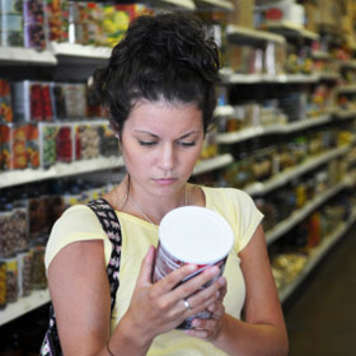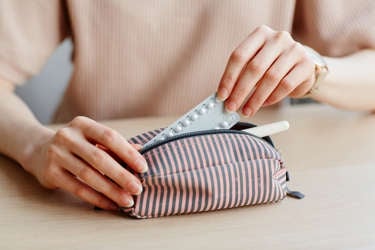
What is sodium?
Sodium is a mineral found in our bodies that helps control the body’s water balance and blood pressure.
You get sodium from the foods you eat. Most of the sodium you eat comes from salt. It might be added when food is being produced or you might add it at home while cooking or about to eat.
Everyone needs some sodium each day. But most people get much more sodium in their diet than they need. This can become a problem for people with high blood pressure. Too much sodium can also be a problem if you are taking steroids.
Read food labels to find out how much salt is present
Reading food labels is a great way to help make sure you do not eat too much salt. The salt content of food is labeled in milligrams (mg) of sodium per serving.
Sodium per serving
Choose products that have less than 200 mg of sodium per serving. For a whole meal, for example three different foods on the same plate, the sodium content should be less than 600 mg per meal.
| Food labels: Nutrition Facts (one serving) | ||
|---|---|---|
| Amount | % Daily Value | |
| Sodium | Less than 200 mg | 8% or less |
The total amount of sodium you can have in a day depends on your condition and age. Health Canada recommends a maximum of 1500 mg of sodium a day for teenagers.
Remember: 1 teaspoon of salt has almost 2400 mg of sodium. One pinch of salt has about 150 mg of sodium.
Ask your dietitian how much sodium you can have each day and write it in your health journal.
Checking ingredient lists
Ingredients are listed in order of weight, from the largest to the smallest. Look for words that mean a food is salty. These words include:
- sodium or salt
- garlic salt, onion salt, celery salt
- brine
- broth
- soy sauce
- monosodium glutamate (MSG)
- baking powder, baking soda
- disodium phosphate or sodium bisulfate
- sodium alginate, sodium benzoate, sodium hydroxide, sodium propionate.
If one of these words is near the start of the ingredient list or if several words are in the list, the food is too salty to eat.
Low-sodium food choices
Vegetables and fruit
You should have ______ servings of vegetables and fruit each day.
| Best choices | Foods to avoid |
|---|---|
| All fresh or plain frozen vegetables | Frozen vegetables with butter or cheese sauces |
| Canned vegetables (check ingredients) | All pickles and sauerkraut |
| Small servings of tomato sauce, tomato puree, spaghetti sauce (check the label) | Tomato and vegetable juices |
| All fresh, frozen or canned fruits and fruit juices (except grapefruit) | Olives |
| Dried fruits |
Breads and cereals
Check food labels and choose products with the lowest sodium content possible.
| Best choices | Foods to avoid |
|---|---|
| Breads: bagels, muffins, toast, tortilla and others | |
| Pasta, noodles and rice | Instant pasta, noodles and rice with flavour packets; canned spaghetti or other pasta |
| Unsalted or "less salty" crackers | Salted crackers |
| Quick cooking cereals and cold cereal | Instant hot cereals |
| Homemade bread stuffing, coating and batter mixes | Commercial bread stuffing, coating and batter mixes |
| Homemade pies, cakes and muffins | Pies, cakes, muffins or biscuits from commercial or frozen mixes |
| Homemade pancakes, French toast and waffles |
Milk and milk alternatives
You should drink ____ cups of milk a day.
| Best choices | Foods to avoid |
|---|---|
| Milk (skim, 1%, 2% or homogenized), evaporated milk, milk desserts, ice cream, sherbets | Buttermilk |
| Cheese - mozzarella, Swiss, goat, ricotta and unsalted cottage cheese (limit to 30-60 mL, or about 1-2 oz, a day) | Processed cheese (slices, spreads, cheese strings) and cheese sauces |
| Cream cheese | Blue, brick, cheddar, feta, Gouda and Parmesan cheese |
| Whipping cream and sour cream |
Meat and alternatives (such as beans, nuts, seeds and eggs)
In general, choose fresh rather than processed meats.
| Best choices | Foods to avoid |
|---|---|
| Fresh beef, pork, lamb, goat, veal, fish, chicken and other poultry, fish and veal | Cured or smoked meats such as bacon, ham, lox, smoked salmon, herring, dried beef or meat sticks (beef jerky) |
| Tuna or salmon canned in water | Tuna, salmon, anchovies or other fish canned in broth or oil |
| Homemade fish sticks, chiecken fingers or nuggets | Kosher prepared meats |
| Unsalted peanut butter | Regular peanut butter |
| Eggs | Luncheon meats such as cold cuts, corned beef, pastrami, pepperoni, sausage, hot dogs, salt pork, canned meats |
| All legumes - lentils, chickpeas, all beans | Frozen battered or breaded fish |
| Unsalted nuts and seeds | Frozen battered or breaded chicken, such as chicken fingers or nuggets |
| Canned chili |
Instant and processed foods
Instead of having instant and processed foods, try some homemade alternatives. These allow you to control the amount of salt you add.
| Best choices | Foods to avoid |
|---|---|
| Homemade or low-sodium soups | Canned soup, powdered soup mixes, instant soup, bouillon cubes such as Oxo and Knorr, instant broth |
| Homemade pasta dishes, chili, baked beans, stew | Canned spaghetti or ravioli, chili, pork and beans or stew |
| Homemade noodles, rice or potato dishes, macaroni and cheese, casseroles | Packaged noodle, ricke or potato dishes, macaroni and cheese, casserole mixes, tacos, sloppy joes and so on |
| Homemade seasonings (or use only half the package of seasoning) | Frozen TV dinners, commercial pizza |
| Homemade pizza (without meat, except for ground beef) |
Salt, baking needs, easoning, condiments and sauces
| Best choices | Foods to avoid |
|---|---|
| Pepper, fresh garlic, garlic powder, fresh onion, onion powder | Table salt, sea salt, Kosher salt, garlic salt, onion salt, celery salt, seasoning salt, popcorn flavourings |
| Ginger, curry and other spices and herbs, Mrs Dash or other salt-free seasoning mixes | Meat tenderizers such as Accent |
| Lemon juice | Baking powder, baking soda (use no more than 5 mL, or 1 teaspoon, a day) |
| Mustard powder, vinegar | Ketchup, mustard, relishes (allow 15 mL, or 1 tablespoon, a day), barbecue sauce, chili sauce, steak or Worcestershire sauce, soy sauce, teriyaki sauce |
| Homemade or low-sodium sauce | Pickles, olives, sauerkraut |
| Margarine, butter, oil | Bacon fat |
| Homemade gravy | Canned gravy, gravy mix |
| Homemade oil and vinegar salad dressings, low-sodium salad dressings | Store-bought salad dressing - maximum 15 mL or 1 tablespoon a day |
Snacks and drinks
| Best choices | Foods to avoid |
|---|---|
| Unsalted potato, tortilla, nacho or corn chips | Regular potato, tortilla, nacho or corn chips |
| Unsalted popcorn or nuts | Regular popcorn, pretzels or nuts |
| Homemade dips without salt | Commercial dips or dips made from packages or dry soup mixes |
| Water | Mineral water with more than 250 mg sodium per litre |
| Fruit juice and drinks (except grapefruit) | Sports drinks |
Eating out and reducing sodium
Here are some tips you can use to get less sodium when you eat out.
Read the menu
Look for words that are a sign of lots of sodium, such as: "marinated," "pickled," "smoked," "soy sauce," "teriyaki sauce," or "in broth." Try not to eat these foods.
Ask the server for help
You can ask the chef not to add salt to your portion. Sauces and gravies often have lots of salt, but you can also ask for these on the side so that you can control how much salt you take in. Use only small amounts of ketchup, mustard, relish, and other sauces and condiments.
Choose less salty fast food items
Most of the foods at fast food restaurants are very salty. Try to eat home-cooked meals using fresh ingredients instead.
If you do eat fast food, follow these tips.
- Hamburgers: Avoid cheese, special sauces, pickles and bacon. Limit other condiments such as mayonnaise, ketchup and mustard.
- French fries: Ask for fries straight from the fryer, before salt is added.
- Pizza: Choose ground beef instead of pepperoni, bacon, sausage or anchovies. Choose onions, pineapple, mushrooms or green peppers instead of olives.
- Chicken: Roasted, broiled or grilled chicken are better choices than breaded or fried chicken. Limit the amount of dipping sauce you use.
- Chinese food: Find a restaurant that does not use MSG. Choose dishes without soy or teriyaki sauce and don’t add soy sauce yourself.






